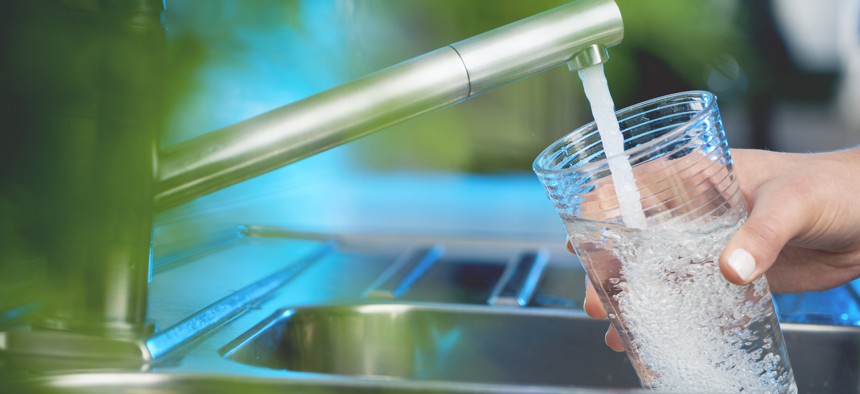Water Bill Assistance Programs Enroll Less Than 25% of Eligible Customers

istock.com/courtneyk
Analysis of the nation’s largest water utility company programs finds that they have narrow eligibility guidelines, including very low income requirements, that exclude customers.
As the nation emerges from the Covid-19 crisis, many economic challenges remain unresolved. Millions remain out of jobs, have unpaid mortgage and rent payments, and have significantly altered their lifestyles and consumption habits to match their reduced incomes.
One thing they have been unable to do is reduce their utility bills, including water and sewer.
In fact, one can only surmise that spending all that time at home has resulted in water consumption and bills going up. But water bills have increasingly been a bigger part of our monthly expenses. Drinking water and wastewater costs have more than doubled since 2000 across the United States. This far exceeds price increases for electricity, rent, and gasoline. Higher water rates are a crippling burden for low-income households.
To address this issue, water utilities have set up customer assistance programs where individuals can enroll and receive discounts on their water and sewer bills, sometimes as much as 80%. So, what’s the problem?
In a report released recently, my co-author and I reviewed customer assistance programs set up by 20 of our nation’s largest water utilities—these are some of the best managed and capable organizations—and found these programs to have too many loopholes and not reach deserving customers.
First off, even among these largest utilities, not everyone provides assistance and those that do, have narrow eligibility guidelines that exclude key customers. Take for instance, the Cleveland Public Water System, which serves 1.3 million residents in Cleveland and its surrounding suburbs. The utility offers two assistance programs: one sets up a much lower tier of charges and the other offers a flat 40% discount. But the catch is that one needs to be a homeowner to access these programs. In a city with less than 40% homeownership, one can only wonder how this program helps low-income residents?
Enrollment rates are hard to assess and where we have little information, it is clear that these programs typically enroll less than 25% of eligible customers. Nowhere is this more obvious than in Philadelphia. The city’s water department was celebrated for its introduction of a tiered-assistance program that pegged rates to income—a first in the country. Its assistance program is otherwise well-designed and avoids the usual pitfalls—the program is open to renters, has a high income threshold, is easy to apply online, and takes into account special hardship conditions. The city includes a surcharge in every bill to finance this program, but with a 25% enrollment rate, more than half of the city’s low-income customers are paying for a program that is intended for them, but they are nevertheless not benefitting from.
We further found that the income thresholds set for assistance are often too low, and the assistance is provided on a “first-come-first-served” basis and last only for a year. Documentation requirements are too high and a lack of coordination with other assistance programs offered by other utilities or the government—think the low-income heat and energy assistance program, LIHEAP or other social services like disability insurance and food stamps—means customers have to apply separately to each program.
In the Covid-19 relief bills approved by Congress in December 2020 and March 2021, the federal government allocated more than $1 billion toward utility debt relief and low-income assistance. But an assessment by the California State Water Board found that in that state alone, 1.6 million households had unpaid bills amounting to more than $1 billion.
More help might be on the way. Bills introduced in Congress, most recently, H.R. 3293 by Reps. Blunt Rochester and Katko, aim to create a federal assistance program at the EPA that will provide funds to local utilities and municipal governments. This could be a game changer as it will remove one of the key bottlenecks for having a robust program -- adequate funding that is not tied to the utility’s rate revenue. But for such a program to be successful, it must avoid the pitfalls that beset existing programs.
Any federal program must eliminate homeownership requirements, allow states to supplement funding, link water assistance to other utility assistance programs or federal programs, provide guidance on required documentation, allow electronic signing and submission, and require utilities to provide as much information about the program publicly on websites and other nonelectronic media.
Water utilities need a viable strategy to ensure that their most disadvantaged customers aren’t shut off from water services. As the Covid-19 crisis demonstrated, water utilities are one economic shock away from a financial crisis. Customer assistance is, at best, a ‘Band-Aid solution’ to the nation’s water affordability challenge. Utilities have a transactional relationship with their customers, but they tend to survive and even thrive when their customers are doing well.
Sridhar Vedachalam is the director of water at the Environmental Policy Innovation Center. He can be reached at sri@policyinnovation.org and on Twitter at @DrVedachalam.
NEXT STORY: Orleans Parish unifies next-gen 911 services in the cloud





